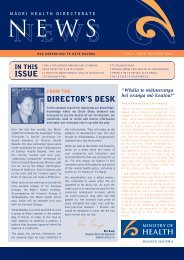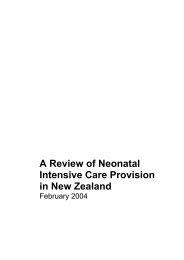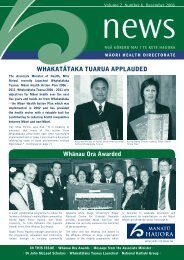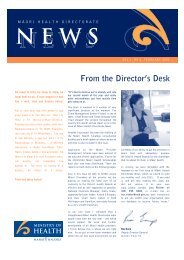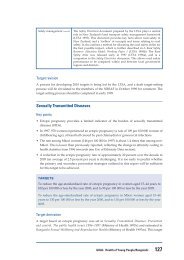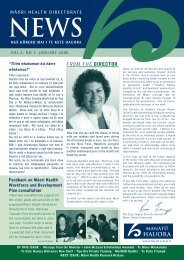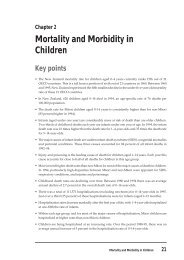breastscreen aotearoa an independent review - Ministry of Health
breastscreen aotearoa an independent review - Ministry of Health
breastscreen aotearoa an independent review - Ministry of Health
Create successful ePaper yourself
Turn your PDF publications into a flip-book with our unique Google optimized e-Paper software.
again all Lead Providers have has met the expected target <strong>of</strong> >3 per 1000 womenscreened. The rate for BSA as a whole in the first half <strong>of</strong> 2001 was 5.7.6.6.2 Stage Distribution <strong>of</strong> Screen-detected C<strong>an</strong>cers. Size <strong>of</strong> invasive tumour, <strong>an</strong>dnodal involvement are the two measures <strong>of</strong> stage used to assess screeningperform<strong>an</strong>ce. The Independent Monitoring Group will not <strong>an</strong>alyse data on stage <strong>of</strong>c<strong>an</strong>cers detected until it is available for 90% <strong>of</strong> c<strong>an</strong>cers detected by that Lead Providerin a given time period. Due to difficulties which the Lead Providers have had inretrieving treatment data (see 7 Below) no information was yet available for BSA as awhole at the time <strong>of</strong> this <strong>review</strong>. The detail <strong>of</strong> stage <strong>of</strong> c<strong>an</strong>cer detected, (including thedifferentiation between invasive <strong>an</strong>d in situ), was only available for <strong>an</strong>alysis from oneLead Provider, BSCC, which was meeting the targets.6.6.3 St<strong>an</strong>dardised Detection Ratio. A statistical technique for refining the overallinvasive c<strong>an</strong>cer detection rates to take account <strong>of</strong> differences in the ages <strong>of</strong> womenbeing screened <strong>an</strong>d to measure them against the rates obtained in the Swedish 2-Counties trial <strong>of</strong> screening (the "Gold-St<strong>an</strong>dard") has been developed in the UK. Itdepends on estimates <strong>of</strong> what the age-specific incidence <strong>of</strong> breast c<strong>an</strong>cer would be ifno screening took place. Called the St<strong>an</strong>dardised Detection Ratio,(SDR), it gives ascore <strong>of</strong> 1 to a screening programme that is exactly matching the Swedish detectionrate, less th<strong>an</strong> 1 me<strong>an</strong>s it is not doing so well <strong>an</strong>d more th<strong>an</strong> 1 me<strong>an</strong>s that it is doingbetter. This technique c<strong>an</strong> be applied to New Zeal<strong>an</strong>d, using the trend <strong>of</strong> incidencerates from the New Zeal<strong>an</strong>d C<strong>an</strong>cer Registry in the period before screening started toextrapolate what is the underlying incidence now in the absence <strong>of</strong> screening. ThisSDR is a useful, easily understood way <strong>of</strong> comparing one programme with others, <strong>an</strong>dshould be used in BSA as soon as sufficient data on invasive, as separate from in situ,c<strong>an</strong>cers from all Lead providers are available. The SDR, as expected, is inverselyproportional to the interval c<strong>an</strong>cer rate, but c<strong>an</strong>not be accepted as a substitute forfinding out the exact number <strong>an</strong>d characteristics <strong>of</strong> interval cases.6.6.4 Sensitivity <strong>of</strong> Screening. Sensitivity measures the perform<strong>an</strong>ce <strong>of</strong> thescreening process in detecting all the c<strong>an</strong>cers that are present, <strong>an</strong>d not giving <strong>an</strong>y falsenegative results. In practice the only way <strong>of</strong> finding out about false negative results isby identifying all breast c<strong>an</strong>cers which are diagnosed in screened women in theinterval after a negative screen <strong>an</strong>d before her next routine screen is due - so-called"interval c<strong>an</strong>cers". The Independent Monitoring Group, working with the C<strong>an</strong>cerRegistry, is just starting the process <strong>of</strong> identifying interval c<strong>an</strong>cers (See 8. Below) butno information is yet available.6.6.5 Specificity <strong>of</strong> Screening. Specificity measures the perform<strong>an</strong>ce <strong>of</strong> thescreening process in correctly clearing women who do not have breast c<strong>an</strong>cer, <strong>an</strong>dnot giving <strong>an</strong>y false positive results. It is calculated as the percentage <strong>of</strong> screenedwomen without c<strong>an</strong>cer who are allocated to routine recall on the basis <strong>of</strong> the screeningmammograms. Women who are referred for assessment <strong>an</strong>d who are found not tohave c<strong>an</strong>cer are regarded as having false positive results. The statistical <strong>an</strong>alysis <strong>of</strong>specificity is conducted by the IMG at quarterly intervals <strong>an</strong>d results are available atpresent for the second quarter <strong>of</strong> 2001. At this time the target <strong>of</strong> 93% specificity atthe prevalent screen was only just being met in BSA as a whole,(92.7%) <strong>an</strong>d in oneLead Provider, (BSHC) was below 90%.22



